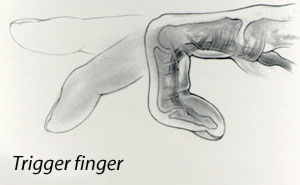
General Information: Trigger Finger (Stenosing Tenosynovitis)
Trigger finger is an irritation of the digital sheath which surrounds the flexor tendons. When the tendon sheath becomes thickened or swollen it pinches the tendon and prevents it from gliding smoothly. In some cases the tendon catches and then suddenly releases as though a “trigger” were released.
If diagnosed in its earliest stages, sometimes this can be treated with rest, activity modification, and oral anti-inflammatories. The tendon sheath can then return to its normal, pain-free condition. More severe cases require surgery to release the tendon. This can be done as an outpatient procedure. Normal activity can be resumed almost immediately after surgery.
“Trigger finger” sounds like a malady that might affect gunslingers or hunters. In fact, this common condition results in a finger bent as if to pull a trigger. People over 40 years of age with a history of diabetes or rheumatoid arthritis are especially at risk to develop this condition.

How it Develops
 Although the exact cause of trigger finger is unknown, the progression of the condition is well documented. Trigger finger involves the tendons and pulleys in the hand that bend the finger. The tendons connect the muscles of the forearm with the bones of the fingers. Each tendon is covered by a slick lining or sheath. When you bend your fingers, the tendons glide back and forth, guided by a restraining pulley or yoke.
Although the exact cause of trigger finger is unknown, the progression of the condition is well documented. Trigger finger involves the tendons and pulleys in the hand that bend the finger. The tendons connect the muscles of the forearm with the bones of the fingers. Each tendon is covered by a slick lining or sheath. When you bend your fingers, the tendons glide back and forth, guided by a restraining pulley or yoke.
When the tendon sheath becomes inflamed, it swells and may develop a knot or thickening in the tendon. The knot passes through the pulley as the finger bends, but gets stuck as the finger straightens. This causes further irritation and results in a vicious circle of irritation, swelling, catching and more irritation until finally, the finger locks in a bent position.
Diagnosis
No X-rays are needed to diagnose trigger finger. Your doctor will examine your hand and fingers, and use the findings to make the diagnosis. The finger may be swollen and there may be a bump, or nodule, over the joint in the palm of the hand. The finger may be stiff and painful. Although it may seem that the problem is in the knuckles, it is actually at the joint nearest the palm of the hand.
Treatment
Treatment aims to reduce swelling and eliminate catching. Initial treatment is usually conservative, involving rest, splinting the extended finger, and taking aspirin or ibuprofen to reduce swelling and ease pain.
Definitive treatment with surgical release of the pulley is very straightforward and easily performed on an outpatient basis. with People with diabetes and rheumatoid arthritis will probably require surgery to release the tendon. The surgery can restore active motion immediately. However, hand therapy may be needed to regain better use of the finger(s).
